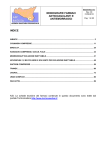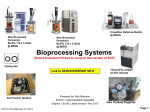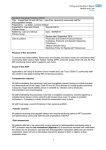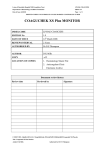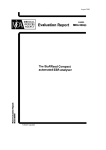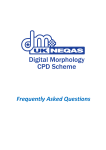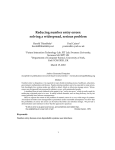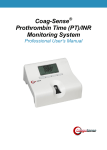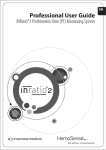Download use of point of care testing device: coaguchek xs plus for all trust staff
Transcript
STANDARD OPERATING PROCEDURE USE OF POINT OF CARE TESTING DEVICE: COAGUCHEK XS PLUS FOR ALL TRUST STAFF Issue History Issue Version One Purpose of Issue/Description of Change To ensure safe point of care testing, using the CoaguChek XS Plus machine, resulting in an accurate INR Planned Review Date 2018 Named Responsible Officer:- Approved by Date Medicines Governance Pharmacist Quality, Patient Experience, and Risk Group March 2015 Target Audience Section:- Medicines Management MMSOP45 All trust staff who use the CoaguChek XS Plus machine as part of their job role UNLESS THIS VERSION HAS BEEN TAKEN DIRECTLY FROM TRUST WEB SITE THERE IS NO ASSURANCE THIS IS THE CORRECT VERSION Ratification Date: March 2015 Page 1 of 10 Use of Point of care testing device:CoaguChek XS Plus for All Trust staff CONTROL RECORD Title Standard Operating Procedure for the use of point of care testing device CoaguChek XS Plus To ensure safe point of care testing, using the CoaguChek XS Plus machine, resulting in an accurate INR. Purpose Author Impact Assessment Quality and Governance Service (QGS) J Edwards Yes No Incorporated into procedure Subject Experts Trust Pharmacist Document Librarian Groups consulted with :Infection Control Approved Date formally approved by Quality, Patient Experience, and Risk Group Method of distribution Archived Access QGS N/A March 2015 March 2015 VERSION CONTROL RECORD Author Status J Edwards/ N Email Date Via QGS Intranet Location:- S Drive QGS Changes / Comments Status – New / Revised / Trust Change Ratification Date: March 2015 Page 2 of 10 Use of Point of care testing device:CoaguChek XS Plus for All Trust staff NAME OF DISCIPLINE: PRIMARY CARE OBJECTIVES To ensure safe point of care testing, using the CoaguChek XS Plus machine, resulting in an accurate INR. . SCOPE The purpose of this document is to: Cover all aspects of point of care testing inclusive of internal and external quality control testing Ensure accurate documentation inclusive of patients record and OAT ( Oral Anticoagulation Therapy) book Ensure safe storage of machine and consumables as per manufacturer’s recommendations. Ensure strips and quality control medium are in date and the code chip number of test strip is recorded in meter for each patient test To be read in conjunction with the CoaguChek XS Plus Operator’s Manual. TARGET GROUP (Staff authorised to follow this SOP) This document does not provide guidance on the: Use of computer decision dosing software – please refer to the manufacturers user manual. Management of high INRs – for information refer to the Wirral High INR Pathway for GP practices or departmental guidance for the DVT Service only All trust staff who have undertaken appropriate training and assessment to competently use the CoaguChek XS Plus machine. EVIDENCE TO SUPPORT PROCEDURE NPSA alert 18 2006 Wirral Anticoagulant (Oral) Therapy Prescribing Guidelines 2012 CoaguChek XS Plus Operator’s Manual RELATED POLICIES Please refer to relevant Trust policies and procedures Wirral CCG Anticoagulation Enhanced Service Agreement (if appropriate) IT IS THE RESPONSIBITITY OF ALL STAFF TO COMPLY WITH RELEVANT TRUST POLICIES, PROCEDURES AND PROTOCOLS IN CONJUNCTION WITH THIS PROCEDURE Ratification Date: March 2015 Page 3 of 10 Use of Point of care testing device:CoaguChek XS Plus for All Trust staff Procedure Activity Rationale Responsibility To ensure accuracy and performance of meter and provide an audit trail for the future Designated user: (General Practitioner, Practice Nurse, Health Care Assistant Advanced Nurse Practitioner, Nurse Practitioner) Designated user 1.Quality Control Internal Quality Control (IQC) Perform IQC weekly as per manufacturer’s instructions (see operator’s manual) and also consider if INR appears out of range for a specific patient. Manufacturers’ recommendations on storage must be adhered to. Document the results in the quality control recording log. External Quality Control (EQC) All practices providing Point of Care testing must have registered with National External Quality Assurance Scheme (NEQAS) Perform EQC as per manufacturer’s instructions when instructed via NEQAS Participating centres in the INR programmes will be sent four surveys per year, each comprising two samples for INR determination. Participants will be provided with instructions on reconstitution and testing of the samples. Results will be analysed, and individual reports sent to participants approximately one week after the closing date of a survey. 2. Performing capillary blood sample INR At the initial appointment on outlining the Point Of Care Testing (POCT) service, explain procedure to patient and obtain informed consent, document in the patient’s record. N.B. POCT INRs have been shown to be unreliable in patients with antiphospholipid antibodies and their use is not recommended in this group of patients. Check that quality control test has been performed within recommended time limits. To ensure external monitoring of device and comparison with other centres using the same device To allow the patient to make an informed decision and gain cooperation Designated user performing sample taking To ensure meter is functioning correctly Designated user performing sample taking. Designated user performing sample taking. Advise patient to wash their hands prior to procedure – assist if necessary Alcohol gel may be used but ensure gel is dry before completing test To prevent sample contamination and warm patients hands to improve blood circulation The designated user must prepare the single use disposable lancet device as per manufacturer’s instructions. Switch the meter on, press patient test button, input patient ID number or add if a new patient. To ensure correct use of equipment To ensure the correct patient identified before proceeding with test Designated user performing sample taking. Designated user performing sample taking. Ratification Date: March 2015 Page 4 of 10 Use of Point of care testing device:CoaguChek XS Plus for All Trust staff Check meter and test strip code match, remove new test strip from vial, replace lid tightly. Slide test strip into test strip guide with lettering facing upwards a beep tone will indicate the meter has detected the strip A blood drop icon will flash to indicate the meter is ready to accept the blood sample Decontaminate hands To ensure meter is calibrated to test strip and to prevent deterioration of remaining strips To ensure the test strip is inserted correctly To remove any accumulated transient skin flora that may have built up under the gloves or acquired during the procedure Apply single use disposable non sterile gloves To protect hands from contamination with organic matter and transfer of microorganisms Using the disposable lancet obtain a blood sample from Side of finger is a less the side of the finger, massage the lanced finger until a painful site to use drop of blood is formed. Do not press or squeeze the To ensure an finger accurate result. Apply one drop of blood directly to the semicircular The test strip draws transparent area of the test strip OR you can touch the up the blood by blood drop against the side of the sample area making capillary action sure to hold the blood drop to the strip until the flashing blood drop icon has disappeared Apply the blood drop to the test strip within 15 seconds To prevent false of lancing the fingertip results due to the coagulation process already beginning Dispose of used lancet into sharps container To reduce the risk of innoculation injury The meter will perform an automatic quality control test on test strip before it displays test result QC will appear in the display The INR result will be displayed and saved to memory Repeat the test if the result is unexplained e.g. below 1.5 or greater than 5. On completion of procedure remove: the test strip from the measurement chamber personal protective equipment (PPE). To ensure accuracy of test. To enable user of the meter to interpret result, document in patient notes and computer decision support software To prevent cross infection and environmental contamination Designated user performing sample taking. Designated user performing sample taking. Designated user performing sample taking. Designated user performing sample taking. Designated user performing sample taking. Designated user performing sample taking. Designated user performing sample taking Designated user performing sample taking Designated user performing sample taking Designated user performing sample taking Designated user performing sample taking Ratification Date: March 2015 Page 5 of 10 Use of Point of care testing device:CoaguChek XS Plus for All Trust staff and dispose of appropriately. Decontaminate hands To remove any accumulated transient skin flora that may have built up under the gloves or acquired during the procedure To prevent cross infection or contamination of further tests Designated user performing sample taking Document all actions observations and INR result (including consent) in the patient’s record and in the Oral Anticoagulation Therapy (OAT) book (yellow book). Ensure compliance with NMC/GMC and local record keeping guidelines If available, input INR result into Clinical Decision Support Software (CDSS) e.g. INR Star To enable Clinician to provide warfarin dose information to be discussed with patient Explain results to patient and any necessary action needed. Document all discussions/actions in clinical systems and OAT book (yellow book) Ensure the next appointment is given to the patient Patient to be fully informed of actions and potential changes to treatment in order to give informed consent Designated user performing sample taking and/or clinician providing clinical input regarding warfarin dose Designated user performing sample taking and/or clinician providing clinical input regarding warfarin dose Designated user performing sample taking and/or clinician providing clinical input regarding warfarin dose Turn the meter off and clean as per manufacturer’s guidance Designated user performing sample taking 3.Documentation If CDSS is used: Ensure that the patient is given the printed diary from INR Star, detailing their result and dosage schedule for each day prior to their next appointment, as well as details of their next appointment Keep a printed file copy of the patient’s dosing diary as a backup in case of IT systems failure 4.Special considerations If any clinical concerns arise regarding the management of the patient or if INR levels are outside of target range; discuss with General Practitioner or authorised prescriber responsible for the patient on the same day as test undertaken and refer to Wirral Anticoagulant (Oral) Therapy Prescribing Guidelines The clinician managing the patient should ensure that all relevant information has been sought from the patient on assessment e.g. General status of patient Has the patient: Had any recent bruising or bleeding To ensure patient safety and correct management of patients on anticoagulation therapy To ensure patient safety and correct management of patients on anticoagulation therapy Designated user performing sample taking and/or clinician providing clinical input regarding warfarin dose Designated user performing sample taking and/or clinician providing clinical input regarding warfarin dose Ratification Date: March 2015 Page 6 of 10 Use of Point of care testing device:CoaguChek XS Plus for All Trust staff Had a recent fall or any other impact injury Any change in medication or diet Commenced any over the counter (OTC) medications Been compliant with warfarin dosing schedule Understood the information given to them at last appointment See appendix 1 for more information relating to this. Failure of machine to produce results. Meter will not register an INR of above 8 A venous blood sample will be required for laboratory INR Following discussions with the identified service anticoagulation lead, ensure collection of a venous blood sample and further dosing as per Lab results. All services participating in INR monitoring are required to maintain a stock of Konakion® MM Paediatric 2mg/0.2mL ampoules for administration to patients with an INR >=8 who do not have major bleeding, The decision to administer Konakion should be made by a clinician (doctor or nurse) with the appropriate knowledge & training, following the High INR pathway or for the DVT Service, departmental guidance To ensure patient safety and correct management of patients on anticoagulation therapy Designated user performing sample taking and/or clinician providing clinical input regarding warfarin dose To ensure patient safety and correct management of patients on anticoagulation therapy Designated user performing sample taking and/or clinician providing clinical input regarding warfarin dose To ensure patient safety and correct management of patients on anticoagulation therapy Designated user performing sample taking and/or clinician providing clinical input regarding warfarin dose To ensure patient safety and correct management of patients on anticoagulation therapy Designated user To ensure patient safety and correct management of patients on Designated user 5. IT system or machine failure If the INRstar dosing programme is not available due to IT system failure. Discuss the INR result with anticoagulation lead clinician referring to printed copies of the dosing diary or summary sheet and yellow book. Failure of the machine to operate. Contact Roche Diagnostics Technical Support Line on 0808 100 19 20, they will try to resolve this over the phone. If the meter is required to be sent in for examination then they will provide you with a loan meter to cover this period. Within your Warranty period (5 years) if it is a meter fault then it will be replaced free of charge, if it is deemed to be a user fault, for example contamination, then this warranty will not apply. Maintenance of the machine As there are no moving parts, no annual maintenance is required, apart from regular Quality Control testing Ratification Date: March 2015 Page 7 of 10 Use of Point of care testing device:CoaguChek XS Plus for All Trust staff anticoagulation therapy EQUALITY ASSESSMENT During the development of this procedure the Trust has considered the clinical needs of each protected characteristic (age, disability, gender, gender reassignment, pregnancy and maternity, race, religion or belief, sexual orientation). There is no clinical evidence of exclusion of these named groups. If staff become aware of any clinical exclusions that impact on the delivery of care, this should be reported using the Trust’s incident reporting system and an appropriate action plan put in place TRAINING SPECIALIST COMPETENCIES OR QUALIFICATIONS CONTINUING EDUCATION & TRAINING RISK ASSESSMENTS ORGANISATION DEPARTMENT (IF APPLICABLE) Refer to the Trust’s Training Matrix. All Clinicians providing warfarin management must complete BMJ e-learning modules initiating and maintaining anticoagulant therapy available on line at www.learning.bmj.com The anticoagulation lead or designated person must ensure the competence of all staff involved in the use of CoaguChek XS Plus machine and INRstar dosing decision software (where appropriate) and be able to provide evidence of competency 1. Staff must comply with the Trust’s Training Matrix which specifies mandatory training requirements. 2.In addition staff must comply with their service level training matrix for training and competencies as required for role Completion of training for use of CoaguChek meter and annual updates, competencies Annual updates in warfarin management and dose decision making Evidence of training updates to be retained in professional portfolio. 3. All staff to have an annual appraisal The service has a responsibility to ensure correct storage and maintenance of the consumables and the CoaguChek XS Plus machine as per manufacturer’s instructions Wirral Community NHS Trust Primary and Unplanned Care Ratification Date: March 2015 Page 8 of 10 Use of Point of care testing device:CoaguChek XS Plus for All Trust staff Individual Authorisation Staff involved in the management of patients on anticoagulation therapy named below based at……………………………………………Service or GP Practice I have read and understood this Standard Operating Procedure and agree to handle the equipment in accordance with this procedure. Name of Employee Signature Practice Anticoagulation lead General Practitioner Date Ratification Date: March 2015 Page 9 of 10 Use of Point of care testing device:CoaguChek XS Plus for All Trust staff Appendix 1 Anti-Coagulation Monitoring Form Answers to these questions will provide information to aid the interpretation of the INR result and guide the clinician when arranging the next appointment. Have any of your details changed? (Phone no, GP etc) Have you had any unexplained bruising, bleeding or unusual headaches since your last visit? Do you, or have you ever suffered with any stomach problems? Have you varied from the warfarin dose shown in your book (or missed any tablets)? Have you been unwell, off your food or are you on a special diet? Have you had any special celebrations or been away on holiday? Have you had any medication changes, any additions, deletions or dose alterations? Do you take any herbal or over the counter medicines? Have you been admitted to hospital since your last clinic visit. Do you have an admission date for the future? Are you likely to be unavailable during the next 3 months? Ratification Date: March 2015 Page 10 of 10 Use of Point of care testing device:CoaguChek XS Plus for All Trust staff











